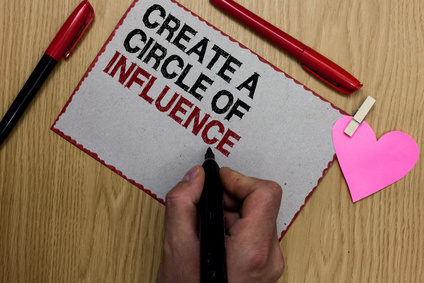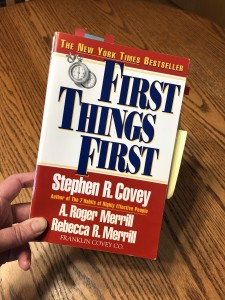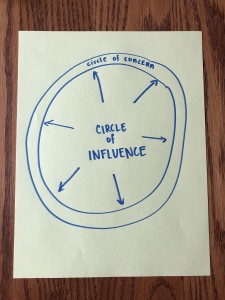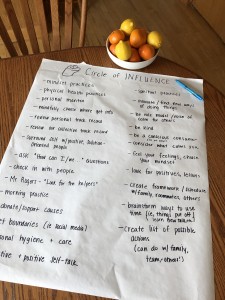
For the past twenty years or so, I have relied on a simple but incredibly empowering tool to help me navigate challenging, uncertain, or downright difficult times. For nearly as long, I have walked countless coaching clients through this tool as well.
I have witnessed this process support people through numerous unexpected difficulties: job losses, health diagnoses, changes in relationship, parenting issues, business upsets, financial hardships … you name it, I have probably drawn two circles on a page to address it.
I call these the Power Circles, and I adapted them from a resource shared in the phenomenal book – one of my all-time favorites – First Things First (Stephen Covey, A. Roger Merrill, Rebecca R. Merrill, Free Press, 1994).

Here’s how it works:
Draw a good-sized circle in the center of a page, then draw a slightly larger circle around it. Label the outer one your Circle of Concern and the center one your Circle of Influence.

Circle of Concern
Let’s start with the outer Circle of Concern. Here is where you can write anything that’s troubling you about the situation, but that you don’t really have any control over. These might include worries, frustrations, fears, ‘what if’ scenarios, ‘why me / why now?’ questions, and anything else that comes to mind.
I often refer to the Circle of Concern as our ‘reactive mode’ circle. It might include those initial feelings that come with change as well as those lingering worries that occupy precious space in our minds.

Get them out of your head and onto paper. We aren’t here to pretend that those things don’t exist, nor to judge ourselves for feeling what we feel. We just want to make sure we focus the majority of our energy where it will best serve us.
Circle of Influence
Now let’s focus on the inner Circle of Influence. Here we’ll do something similar, however this time we’re writing down any and all things we can do to change, improve, alter, or otherwise impact the situation or some small part therein.
When you’re in the midst of a difficult time, this proactive focus doesn’t always come easily – but challenge yourself to do it anyway. You can also seek input from your coach or trusted others. Get as many ideas onto paper as you can; you are not committing to all of them, you’re simply brainstorming (or what I heard recently referred to as ‘heartstorming’ – I like that :-)).
I will admit, part of me really wants to call this the Circle of Control, because that languaging – ‘focus on what’s in your control’ – tends to help in times of uncertainty. But as Covey et al explains, when we focus our energy over time on that center circle, “We find positive ways to influence more people and circumstances.” We can’t necessarily control people and circumstances, but we can influence them – or our relationship with them.
The great thing about focusing on the Circle of Influence is that as we do, it actually expands – making the Circle of Concern smaller at the same time.

I like to imagine my mind in this way, too: The more I come up with solutions and actions, the less space available for my concerns and worries.
A Timely Example
The other morning, I woke up concerned – like all of you, I’m sure – about our current pandemic situation. I acknowledged my feelings, then started asking myself some questions:
What can I do?
How can I help?
What actions can I take?
I pulled out my journal and – you guessed it – drew two circles.
I began with the outer Circle of Concern. I imagine my concerns are similar to yours, so I won’t delve into detail with them here. After listing a handful in my journal, I knew it was time to shift gears.
I then challenged myself to come up with a variety of actions I/we could take, things we could focus on, ideas that might help. Again, this is not a to-do list or commitment page; it’s a brainstorm/heartstorm.
Here are some that appeared on my list:
1. Make mindset practices part of your routine: Journaling, daily intention, gratitudes, affirmations, e.g.
2. Engage in the physical health practices that serve you: Nutrition, exercise, sleep, e.g.
3. Develop a personal mantra: A quick phrase you can memorize and repeat as needed, such as “This too shall pass” or “What can I do in this very moment?”
4. Mindfully choose where you get your information. And how much, too.
5. Review your personal track record. You’ve likely been through countless challenges and difficulties throughout your life. What has helped you through them?
6. Review our collective track record. Our communities, countries, and world have faced challenges and difficulties in the past as well. What has helped in those times?
7. Surround yourself with positive, solution-oriented people. Everyone may experience myriad emotions at any time, of course, but having conversations around the Circle of Influence can do wonders for our energy, mood, and sense of personal agency.
8. Ask “How can I/we…” questions. This type of open-ended questioning increases your likelihood of generating solutions rather than lingering in less-helpful modes.
9. Check in with people: Friends, family, loved ones, those who might not have someone calling or texting them.
10. Embrace Mr. Rogers’ wisdom to “look for the helpers”: Care providers, researchers, responders, people supporting the homeless, scientists, teachers looking for different ways to support their students, therapists, grocery store workers… There are countless helpers!
11. Continue (or develop) a morning practice. How you begin the day will often set the tone for your day. Journaling, exercise, prayer, meditation, visualization, and many other options exist.

12. Donate to or otherwise support causes making a difference. I’ve also talked with many people purchasing gift cards from small businesses that must temporarily close – such a meaningful gesture.
13. Set boundaries: With social media, news sites, and internet, for example.
14. Practice personal hygiene and care: Wash your hands and honor the recommendations placed by the experts, for example.
15. Engage in proactive and positive self-talk. #3 and #8 can help with this.
16. Honor your spiritual practices. Prayer, meditation, and/or other actions that connect you to your faith.
17. Innovate/Find new ways of doing things. How can you adapt your gym workout to your current surroundings, for example? Or how could you continue to support your team even if you’re not in the office together?
18. Be a role model/voice of calm for others. As written in First Things First, “We may not be the leader, but we are a leader.” Lead with compassion, kindness, optimism, and/or whatever rises to the surface for you. Somebody is paying attention (probably many somebodies).
19. Be kind. Trust that everyone is doing the best they can, even if their methods don’t match yours.
20. Be a conscious consumer, in all ways: Information, purchases, etc.
21. Consider – and invite more of – what calms you: Music, crafts, repetitive actions like sewing or cross-stitching, funny movies, e.g.
22. Feel your feelings, choose your mindset. Don’t judge yourself for however you feel. And employ your power to choose your mindset.
23. Look for positives, lessons, bright spots. Maybe you’re eating dinner as a family, or maybe you witnessed a beautiful act of kindness (there have been so many). Challenge yourself to seek out silver linings.
24. Create a schedule – or at least a framework – with family, roommates, coworkers who may now be working remotely, e.g.
25. Brainstorm ways to meaningfully use your time. Declutter your closet, play a game with your family member, organize your home office, learn a new skill, practice an instrument, read, bake, create, do something you’ve put off for ages.
26. Create your own list of possible actions! You can do this alone and/or with your family, team members, or others.
Moving Forward
Here’s how I picture this:
When faced with a challenge – whether it’s what we collectively are navigating as a world or something in your own work or life – instead of throwing your hands up in fear or frustration, open your hands up and invite solutions.

Ask yourself new questions. Challenge yourself to generate solutions, ideas, and possibilities. Focus on what you can influence, not on what you cannot.
Be gentle with yourself and others.
Empower yourself and others.
Let’s move through this together!
P.S. You can watch my video about this tool here.
What would you add to the above list? Share your additions below or on Instagram or Facebook.
Christi Hegstad, PhD, PCC is the Certified Executive + Personal Coach for difference-making achievers! Clarify your vision, free up time, and confidently reach bold goals with meaning and purpose! Contact us today for coaching, speaking, and Mastermind opportunities, or click here and fill in the blue box to join our email community.





